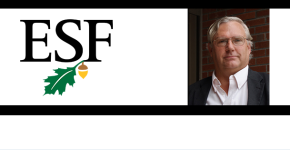 Cutting edge technology could revive an old economy.
Cutting edge technology could revive an old economy.
Thomas Amidon, professor of paper and bioprocess engineering at the State of New York University of Environmental Sciences and Forestry, explains how forests can be used in the future.
- Professor and Chair, Department of Paper and Bioprocess Engineering, SUNY College of Environmental Science and Forestry 6/2000-Present
- International Paper, 1976-6/2000
- Laboratory Manager, Corporate Research Center, Tuxedo, NY, 1994-6/2000
- Manager, Primary Process Development, Corporate Research Center, Tuxedo, NY 1989-1994
- Quality Improvement Process Facilitator, Process Technology, Mobile, AL 1987-1989
- Program manager for wood and pulp properties, Pulp Manufacturing Technical Support group, Mobile, AL. 1984-1987
- Manager, Forest Sciences, 1982-1984
- Research Analyst 1980-1982
- Research Associate and Senior Research Associate 1976-1980
- Instructor, SUNY College of Environmental Science and Forestry, Department of Paper and Bioprocess Engineering; Postdoctoral Associate, Empire State Paper Research Institute 1974-1976
New Forest Economy

The key aims of the New Forest Economy are to use the natural resources of the forest regions in the United States in an integrated model to create jobs and community wealth. We can revive shuttered pulp and paper mills with cutting-edge technology, like hot water extraction processing and we can use forest resources to manufacture a minimum of 15 sustainable bioproducts in a cost-effective manner, chemicals that are now imported or manufactured using dirty technology. Ethanol, butanol, methanol and algal biodiesels can also be produced using the fermented sugars generated in the process.
In addition to producing bioproducts and reviving manufacturing opportunities in depressed communities, this system can produce food with a smaller carbon footprint by using waste heat from the extraction process to heat greenhouses to grow fruits and vegetables.
Hot water extraction is an advanced green technology wood fractionation process that can also reduce pressure on forest resource consumption by improving the economic return on wood fiber and by using alternative fiber-based materials as lignocellutosic feedstock such as hybrid willow and grass-lie materials.
Initially, there will be six designated sites in New York to demonstrate this new approach to development. As many as 30 sites are being developed nationally with partnerships in Ohio, Washington state, Kentucky and Minnesota. The Northeast mega-region along the Interstate 95 corridor is also a major target for development to ease congestion and pollution along the east coast by connecting rural production facilities to major markets shortening the distance key products travel from source to destination.
The New Forest Economy is a model to redesign existing post-industrial manufacturing assets, reinvest in them and capitalize on new business opportunities using clean, green technology.
